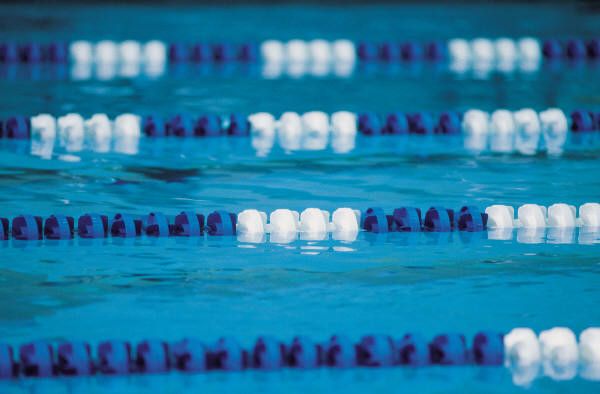Aquatic Facilities

Public aquatic facilities offer a variety of recreational opportunities across Alaska.
Protect the health and safety of swimmers by following requirements for building, maintaining, and operating pools and spas.
- Questions about aquatic facilities?
- Contact your local Environmental Health Officer.
On This Page
Aquatic Facilities in Alaska
Public swimming pools and spas are regulated by the State, except within the Municipality of Anchorage. This includes pools and spas at hotels and other overnight accommodations, but does not include facilities at private residences.
Public Swimming Pools
A public swimming pool is any pool that has a depth of two feet or more at any point and is intended to be used by the public for swimming, diving, or recreational bathing.
A fee may or may not be charged for use of the pool and the pool is operated by an owner, agent, lessee, operator, licensee, or concessionaire.
Public Spas
A public spa is any contained pool or area of water that has a depth of no more than 3.28 feet and is designed for recreational or therapeutic use. This includes hot tubs and whirlpools.
A fee may or may not be charged for use of the spa and the spa is operated by an owner, lessee, operator, or concessionaire.
Certified Pool Operator Training Requirement
Public swimming pools and spas in Alaska are required to have at least one certified operator.
Certified Pool/Spa Operator® training is maintained by the Pool & Hot Tub Alliance. Other organizations may also have certified instructors who teach the training course online or locally and in-person.
Training in Alaska
No local Certified Pool/Spa Operator® courses are scheduled at this time.
Water Sample Requirements
Routine water samples must be collected when aquatic facilities are being used. At least once each month, a water sample needs to be collected at a point near the outlet of the pool and at any other points designated by the Department of Environmental Conservation.
These water samples are required to be examined by a laboratory certified by the Department under 18 AAC 80. In addition, samples must be collected and examined in accordance with the American Public Health Association's Standard Methods for the Examination of Water and Wastewater, 16th Edition, 1985.
Routine water samples may not
- Contain more than 200 bacteria per milliliter, as determined by the standard (heterotrophic) agar plate count (35° C); or
- Show positive test
- For coliform organisms in any of the five 10 milliliter portions of a sample; or
- For more than zero coliforms organisms per 100 milliliter when the membrane filter test is used.
If a water sample from an aquatic facility tests positive for pseudomonas or other pathogens, contact the facility's local Environmental Health Officer. The pool or spa must close until sampling shows that the water is free of the pathogen.
The Department may also increase the frequency of water sampling at aquatic facilities to assure that the pool water meets the standards of 18 AAC 30.550.
Best Practices for Aquatic Facilities
The Model Aquatic Health Code provides current best practices for the design, construction, operation, and management of public pools and spas. This guidance is up-to-date on science and research in the area of aquatic facilities.
Visit the Model Aquatic Health Code website for more information about the code's guidance and for resources related to communication, tools, and training.
State Inspection Checklist
The list below describes the items that are checked during State inspections of aquatic facilities.
The  symbol indicates items that are critical violations.
symbol indicates items that are critical violations.
Pool and Spa Area
- Access and separation

- Protected electrical receptacles

- Grab rails, ladders secured; shell, deck in good repair

- Float/safety line clearly present
- "Depth" and "No Diving" markers
- Skimmers: Weirs and baskets installed; clean and operating; covers in good repair
- Recirculation inlets functional
- Main drain grate secured in place and in good repair

- Water is clear, main drain is visible

- Pool/spa deck is free from obstructions
- Lifesaving equipment present and in good repair

- Supervision of aquatic facility

- Signs: Bathing load, rules
- Spa temperature is 104 degrees Fahrenheit or below
- Starting platforms removed, covered, or access blocked
- Emergency phone or other communication device available and well-marked; first aid kit available
Water and Chemicals
- Test kits
- Proper disinfectant level

- Proper pH level

- Combined chlorine at acceptable levels
- Cyanuric acid not used
Water Quality Readings
| Item | Pool Requirement | Spa Requirement |
|---|---|---|
| Total available chlorine | Between 2.0 mg/L and 10.0 mg/L | Between 2.0 mg/L and 10.0 mg/L, must be greater than one-half of total chlorine for proper disinfection |
| Free available chlorine (if chlorine is used as a disinfectant) | Must be at a level that provides a molecular hypochlorous (HOCl) yield of 0.3 mg/L or above according to Table E | Between 2.0 mg/L and 10.0 mg/L, must be greater than one-half of total chlorine for proper disinfection |
| Free chlorine residual | Between 2.0 mg/L and 10 mg/L | |
| Combined chlorine | Chloramines may not exceed one-half of the total chlorine level | |
| Free available bromine | Between 2.0 mg/L and 4.0 mg/L | Between 6.0 mg/L and 10.0 mg/L |
| pH | Between 7.0 and 8.0 when in use | Between 7.2 and 7.6 when in use |
| Total alkalinity | Between 100 mg/L and 140 mg/L | |
| Alkalinity | Between 50 mg/L and 200 mg/L | |
| Total hardness | Between 100 mg/L and 1,000 mg/L | |
| Calcium hardness | At least 70 percent of the total hardness | Between 150 mg/L and 500 mg/L |
| Water temperature | 104 degrees Fahrenheit or below |
Equipment and Chemical Room
- Automated feeder operable
- Automated controller operable
- Piping and valves identified and marked
- Flow meter present and operating
- Recirculation pump: approved, good repair, operating

- Filter: Approved, good repair, operating

- Pump strainer; baskets in good condition, not clogged
- Filter gauges operable: Filter inlet and outlet, strainer; sight glass
- Proper functioning UV system; ozone system
- Chemicals: Labeled, stored safely, secured

- Appropriate personal protective equipment (PPE) available
Hygiene Facilities
- Diaper changing station present; sink, adjacent trash can, sanitizer
- Used equipment separated from cleaned equipment
- Toilets: Clean, good repair, restroom appropriately stocked
- Rinse showers: Good repair, accessible
- Cleansing showers: Warm, non-scalding water available; good repair; soap
Records
- Operator training certification available onsite
- Lifeguard training certification available onsite
- Operator inspection daily items: Checklist used daily
- Operator inspection items: Evidence of appropriate steps promptly taken
- Chemical records: Filled out daily
- Chemical records: Evidence of appropriate steps promptly taken
- Emergency Action Plan available on site
General
- Substantial unauthorized alterations/equipment replacement
Regulatory References
- 18 AAC 30.500 Public Swimming Pools and Spas
Resources and Contacts
Resources
- Public Facility Application
- The Department of Environmental Conservation's application for aquatic facilities
- Model Aquatic Health Code
- Federal guidance on best practices for aquatic facilities
- Poop in the Pool
- Federal guidance for responding to pool contamination events
- Vomit and Blood on Pool Surfaces
- Federal guidance for responding to pool contamination events
- Vomit and Blood in the Pool
- Federal guidance for responding to pool contamination events
Contacts
- Food Safety and Sanitation
- Find your local Environmental Health Officer

 Indicates an external site.
Indicates an external site.